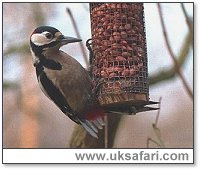
|

|
|
 Sent
to you Sent
to you
by e-mail
|
|
Simply
enter your details and hit the send button
more
info |
|


Click Here

Links
Advertise
Terms of Use
Contributors
About Us
Contact Us
|
 |
Go back
 | Bookmark
| Bookmark
 | Print Page
| Print Page  | E-Mail Us
| E-Mail Us 
 
 Photo: G. Bradley
Photo: G. Bradley
|
|
UK
Safari Tip:
Get help identifying birds with the superbly illustrated "Top 50
Garden Birds" identification chart - click
here
|
|
Create
Your own back Garden Nature Reserve
As the human population grows, and the demand for more new houses and roads
gradually eats away at our countryside, the value of urban gardens as a safe
refuge for wildlife becomes ever more important.
It doesn't matter
whether you have a large garden or just a window ledge, you can create an area
that is pleasant to look at, easy to maintain, and attractive to wildlife.
How to Attract Wildlife
There are just three magic ingredients which any wild creature visiting your
garden will be looking for:
1. Food
2. Water
3. Shelter and a place to raise young
They can turn an ordinary lifeless backyard into a habitat abounding in songbirds,
butterflies, squirrels and a myriad of little creatures. These
ingredients probably already exist in your neighborhood. All you need to do is
enhance the supply, or add the missing basics to create an active wildlife
environment. Read on for more info.

1. Food
The easiest way to attract birds to your garden is to put food out for them,
especially in the winter months when natural food is scarce. Once you start
feeding it is important that you don't stop, or the birds could starve. Once
they learn where to find food they'll keep coming back.
Birds will take a variety of food, depending on the species, including; bread,
nuts, sunflower seeds, fruit, tinned dog food and cooked potato.
You can leave the food on the ground, hanging from a tree, or on a purpose built
bird table. You might find that this food will also attract other animals such as
red / grey squirrels,
foxes and possibly badgers
(depending on what lives in your area).
A hedgehog in your garden makes an ideal pest controller. They eat creatures
which most gardeners view as enemies such as slugs, snails,
beetles and caterpillars. They are cheaper, safer, and a good deal more attractive than slug
pellets. You can attract them by leaving out some tinned dog food.
Many of the native wildflowers, which most gardeners view as weeds, are not only
beautiful to look at, but are vital food plants for many species of butterflies
and other insects. If you can, set aside an area of your garden for plants such
as foxgloves, campion, thistles and
willowherb. If you have limited space you
could try growing them in containers.
Here are some more flowers to attract butterflies:
Buddleia (Buddleia davidii)
Ice Plant (Sedum spectabile)
Lavender (Lavendula var)
Michaelmas Daisies (Aster-novi-belgii)
Primrose (Primula vulgaris)
Sweet William (Dianthus barbatus)
Forget-Me-Nots (Myosotis var)
Globe Thistle (Echinops ritro)
Ivy (Hedera helix)

2. Water
Birds and animals need to drink water all year round. A shallow dish or tray is
sufficient, but birds also like to bathe in water, so the larger the container
is, the better.
An ideal way to provide water is to create a pond by digging a hole, and lining
it with plastic held down at the edges with stones. Make sure that it has
shallow sides (not steep), so that if any animals fall in they can easily walk
back out again. If you are keeping fish in the pond, it will need to be deep
enough for the fish to swim well below the ice when the surface freezes over in
winter.
A pond will also provide a home, and a place to raise young, for many other
species such as frogs, newts, toads, dragonflies, damselflies and other insects.

3. Shelter and a Place to Raise Young
Trees and shrubs are an excellent and natural way to provide shelter for
wildlife. Try to use native species where possible. Hedges made from hawthorn,
holly and yew also produce berries which are a good source of food for birds in
the colder months.
A pile of logs will provide shelter and homes for insects and many creepy-crawlies. Although these may not seem like desirable things to have in
your garden, they will in turn provide food for other visiting animals.
Log piles make an excellent place for frogs, toads,
lizards, hedgehogs and other
wildlife species to shelter, find food, and raise their young. Build a permanent
log pile in a shaded area, and let it decay naturally.
If you lean a sheet of wood at an angle against a wall, and stuff it with dry
leaves this will provide a suitable nest for hedgehogs. They will also nest
under raised sheds, and beneath hedgerows, as long as there are plenty of dry
leaves for bedding.
A good way to provide shelter for birds is to put up a nest box. These can be
bought from most garden centres and pet shops, but if you want to have a go at
making one yourself, Click Here for a printable plan.

How to Keep the Neighbours Happy
Some people worry that if they set aside an area of their garden for wildlife,
it will look untidy or just neglected. A simple way to avoid this is to put a border around the
area.
This will make your wild space look like an intentional project.
The border could be a narrow path made of gravel, woodchip or grass, or it could
be a hedge made of privet or holly. Putting a border around it will make it look
controlled and contained.

How to Attract more Butterflies to your Garden
UK Safari Members Area - factsheets on
attracting butterflies, bats, bees and more.
|
 |

|